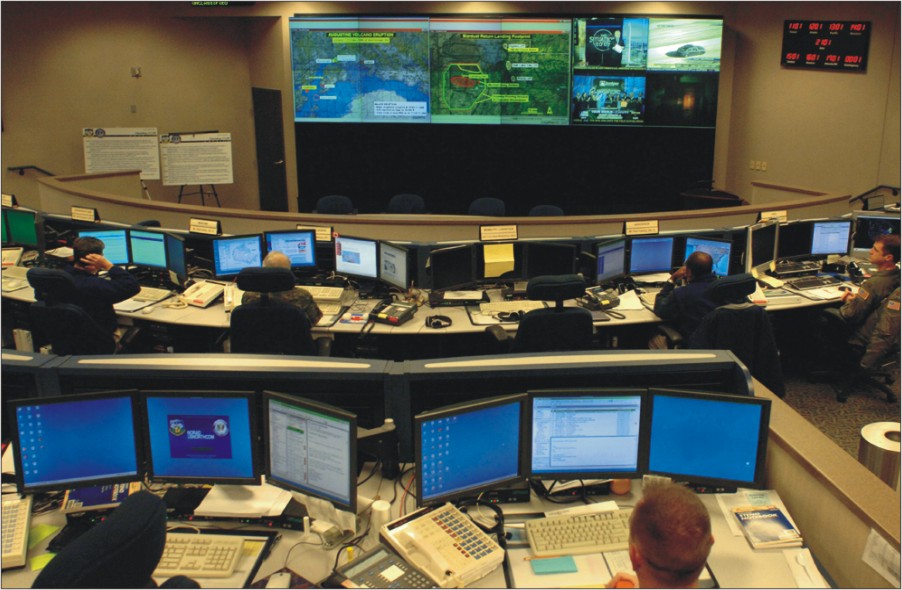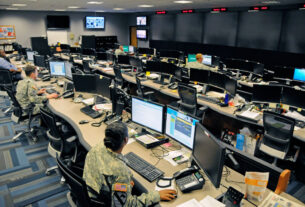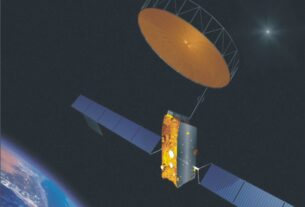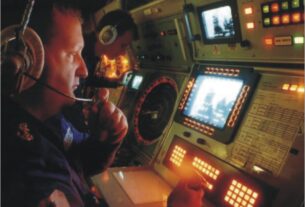Network centric warfare or NCW is redefining the future battlespace. In the information age, power is increasingly derived from information sharing, information access and speed. The Indian armed forces are moving fast in this direction.
Modern age is of technology and information. The numerical strength does not matter; it is the level of technological advancement and superiority that matters. It is expected that future wars would be limited, swift and quick. Only those countries will make the difference, which possesses Network Centric Warfare (NCW) and Electronic Warfare (EW) capabilities.
Initiated by US DoD, NCW relies on computer processing power and networking communications technology to provide shared information of the battle space among armed forces. This shared awareness increases synergy for command and control, resulting in superior decision- making, and the ability to coordinate complex military operations over long distances for an overwhelming war-fighting advantage.
As future conflicts will be fought in a technology intensive environment, NCW is an information superiority-enabled concept of operations that generates increased combat power by networking sensors, decision makers, and shooters to achieve shared awareness, increased speed of command, higher tempo of operations, greater lethality, increased survivability, and a degree of self synchronization. The Network Centricity in warfare is enabled by advances made in technologies for what are called the C4ISR (Command Control Communication Computers Intelligence Surveillance and Reconnaissance) Systems.
Shared connectivity
The pace of the future battle will be so swift that there will be no time to revert to the rear headquarters all the time for instructions and advice. Strategically, NCW allows an understanding of all elements of battlespace and battle time; operationally it provides a close linkage between the units and the operating environment; and tactically it provides speed.
In essence, NCW translates information superiority into combat power by effectively linking knowledgeable entities in the battlespace. The detection of enemy presence, processing of targets, command decision making and engagements have become possible through creation of collaborative networking amongst sensors, command and control elements and weapons. Emergence of new technologies has created the conditions for network centric computing.
The recognition of information dominance in future wars is based on the success of information dominated military command and control, in influencing outcome of the battle.
The usage of information technology as a force multiplier in warfare stems from the belief that information advantage leads to information superiority eventually enhancing combat effectiveness of platforms. This is achieved by “networking” of sensors, decision-makers, and shooting platforms, thereby creating shared awareness, speed of command, high-tempo maneuver, close coordination and synchronization during operations resulting in greater lethality, and enhanced combat capabilities. The primary objective of applying modern information technology is to enhance battle-space awareness between operational and command elements.
Indian Armed Forces, surrounded by hostile adversaries and difficult terrain, needs to have strong net centric warfare capabilities to counter any possible threat in future in the shortest span of time. Having realized the potential of NCW all the three services, IAF, Indian Army and Indian Navy, are working in the direction to acquire sophisticated technology so that they can coordinate among themselves in a better way in case of any future war scenario.
India has been progressing quite well in this field and the Indian military in fast few years has introduced and practiced its latest weapon & equipment, force multipliers like LORROS, FMCP, AWACS, UAVs, Satellites, battlefield surveillance radars, weapon locating radars, and mechanized forces. From 2004 to 2012 Indian military has practiced its NCW capabilities in almost every exercise.
India’s preparedness
The Indian Army has launched an ambitious program for transforming itself into a net centric force. It has over the period evolved a doctrine for integrating various components of C4I2 together with an Information Warfare (IW) doctrine, given the growing nature of threat in the neighborhood.
Indian army has made advancement in the field of NCW. Indian army developed a robust, survivable and high speed Common User Network across the country. Army Switched Communication Network, Command Inter communication Network, Army Wide Area Network and Army Radio Engineered Network have been established to provide robust Communication Networks across the length and breadth of the country. Indian army is now upgrading these systems to meet challenges in the modern age.
Indian army is working on many projects like Network for Spectrum, ASCON Phase IV, and Tactical Communication System. These systems are in progress and near to the stage of implementation. These systems will provide robust communication network system to the Indian Army.
Apart from this Indian army has inducted the Artillery Combat and Control System (ACCCS) Shakti, which is the artillery component of TAC 31. ACCCS will provide Indian army an advantage in the theatre of war. With the help of this system Indian army will be able to use lethal firepower with accuracy and precision against enemy positions.
An effective communication provides the backend of sensor connectivity to generate synergistic effect. Within this construct Indian Army is developing a Tactical Communication System, providing both the bandwidth for data sharing and seamless connectivity. The TCS being conceived for the force will bridge the gap between existing and contemporary technologies in the sphere of military communication.
Another important component of the Indian Army’s transformational perspective is developing capacities for “cyber warfare”. It is a potent instrument of war with means to weaken enemy capabilities even before battle is joined.
Like the army the Indian Air Force is in the advance stages of developing an integrated network in terms of a layered, hardened and in-depth
air defence command, control and communications network, called IACCCS (Integrated air Command, Control and Communications System).
Integrated Air Command and Control System (IACCS) is an automated command and control system for Air Defence (AD) planned by the Indian Air Force. IACCS operations will ride the Air Force Network (AFNET) backbone integrating all ground-based and airborne sensors, AD weapon systems and C2 nodes. Subsequent integration with other services networks and civil radars will provide an integrated Air Situation Picture to operators to carry out AD role.[1]
Through the IACCS, IAF will connect all of its space, air and ground assets quickly, for total awareness of a region. This will offer connectivity for all the ground platforms and airborne platforms, as a part of the network centricity of IAF. The IACCS also facilitates real-time transport of images, data and voice, amongst satellites, aircraft and ground stations.
Indian Navy plans to create and sustain a three dimensional, technology enabled network centric system to transform itself into a formidable sea power. Indian navy’s radical shift in its strategic outlook is clearly exemplified by the fact that it is aiming for a global reach from being a regional sea power focused only on the threats from China and Pakistan.
To boost its strike capability, Indian navy is quite keen to link up its long range missiles, radars and air defence systems on all the sea bed assets to a centralized and a dedicated satellite network.
Last year Indian Navy carried out a theatre level readiness and operational exercise, TROPEX. In this exercise the navy demonstrated its war readiness and NCW capabilities. It demonstrated synergy and integration between two completely networked fleets, which were widely, dispersed in the Indian Ocean. These fleets were operating in an electronic environment to display their capabilities to carry out operations under NCW environment.
Satellites are essential part of NCW or EW capabilities. Indian military has also developed its space based assets to augment its NCW and EW capabilities.
Navy is aware that the key to harnessing the full potentials of such an advanced technology driven system lies in enhanced maritime domain awareness based on availability of satellite resources on an uninterrupted basis. The Indian navy’s immediate requirement is essentially to acquire a dedicated, conventional satellite system to ensure a smoother, faster and a secure communications link for a better coordination of its assets.
The information superiority, surveillance and target acquisition were all key aspects in making the Indian Military modern and high tech for their network centric capabilities. In essence moving away from platform centric to network centric and create complete battlefield transparency.
Becoming a more modern and high tech military is a key aspect in India’s massive spending strategy. This already includes the Futuristic Infantry Solider as a System (F-INSAS) which is a system that will allow soldiers to have the capability to fight in network centric warfare and electronic warfare environments. Added to this, new mini laptops and GPS systems are currently being sought in order to fully digitize the troops.
In addition to this, the IAF’s Air Force Net (AFNET) is the backbone of its network centric warfare capability. The system is a fibre optic-based network on which the Integrated Air Command and Control System (IACCS) is used. When the system was launched it linked all systems within its ground, air and space assets and gave complete situational awareness of the area it wanted to secure and dominate.
This shared awareness on a faster and more inter-operable system made for more synergy between command and control and the ability to make complex decisions away from the front line and gives the troops greater warfighting advantage.
The defence communication technologies such as tactical radios and military satellite and network-centric communications are the key technologies driving funding in the defence market. Additionally, the next generation of technological development for military communications will be greatly influenced by the goal of a fully interoperable solution.
Naval capability
For centuries, navigators, surveyors and explorers used the sextant and celestial bodies to locate their navigational position with some accuracy to avoid tragedy, and to arrive at their intended destinations.
In the 1990s, the Indian Navy was the first Service to introduce the Magnavox receivers on major ships and soon the Indian Air Force and Army followed. The tiny computer box with its small antenna was fondly referred to as ‘Commander Magnavox’ in the Navy and when commanding officers wanted to test navigational skills of their officers, Cdr Magnavox was purposely switched off; they were back to the sextant and astro tables.
The applications of GPS has changed most civil and military applications that need accuracy of navigation and is today invariably linked into systems including internet and is very widely used in military operations and surveys, intelligence and missile and weapon control and direction.
Keeping in league with the maritime powers of the world having top line navigation system, the Indian Navy eyes to get a network of satellites to enhance its NCW capability.
Its major space programs include the Indian Regional Navigational Satellite System (IRNSS)-GAGAN and ship-borne internet communications linked system with an ISRO launched satellite. It will assist the Indian Navy become an advanced network centric warfare (NCW) capable war-fighting arm.
Further in a major success, India’s first dedicated military satellite was placed into orbit recently by the Ariane-5 rocket, launched from Kourou, French Guiana. The satellite will be exclusively used by the Indian Navy that’s so far had to share bandwidth on India’s existing space platforms, including the INMARSAT family of satellites.
The GSAT-7 will be activated for operations in mid September in a geostationary orbit 36,0000-km above the equator.
GSAT-7 is an advanced communication satellite built by ISRO to provide wide range of service spectrum from low bit rate voice to high bit rate data communication. GSAT-7 Communication payload is designed to provide communication capabilities to users over a wide oceanic region including the Indian land-mass. The payload configuration is compatible with I-2.5K bus of ISRO. The GSAT-7 payload design includes Multiband communication.
The military satellite will cover an area of over 1,000 nautical miles over the Indian Ocean Region (IOR) stretching from Africa’s east coast up till Malacca Strait. The idea is to enable the naval force to network its warships, submarines and aircraft with operational centres ashore through high-speed data-links.
The pivotal role of the naval surveillance and communication satellite is to create synergy between its combat platforms and its land-based nodes through advanced communications and space systems. The intention is to turn the Indian Navy into a force geared towards network-centric operations for future challenges.
For the Indian Navy, the dedicated satellite will boost the maritime capabilities significantly at a time when the Indian Ocean region is greatly vulnerable to various threats including piracy as well as increasing Chinese presence in the region. It will enable the effective surveillance of that region to ensure that no foul play goes unnoticed and the s SLOCs is protected.
With the access to OCEANSAT satellites, acquisition of reconnaissance aircraft P-8I, availability of modern radars and unmanned vehicles with strong communication network, the Indian Navy has not been lacking in the field of its efforts to augment its C4ISR capabilities.
With advanced net centric network the exchange between ships and headquarters will be in real time. The result will be that the Indian Navy will be marching towards full net centricity very soon. India’s march towards modern, safe and secure global positioning, navigation and data transmission in the Indian Ocean has begun and India believes in cooperation with the littoral states and to provide facilities in the Indian Ocean Rim (IOR) countries.
As a long term vision, Indian Navy is keen to operate an exclusive satellite supported by a constellation of spacecraft to meet the challenges lying ahead.
Interoperability
A vital requirement in a networked system is not only interoperability of the system under development but also facilitation of information sharing among systems that were not originally designed to talk to each other. For inter-Services interoperability, there is requirement of a comprehensive and well documented tri-service model which forms the basis for reference at the conceptual and development stage.
There are also reports which indicate that the tri-services defence communication network (DCN) is being progressed as per the defence procurement procedure. The DCN envisages a network of optical fiber cables, satellite, earth stations and transportable and portable satellite terminals with high security features.
The ability to support NCW operations across the three Services would hinge around effective collaboration, information integrity, effective presentation and empowered dismounted users.
In an NCW environment, the information should be available when needed, should be trustworthy, real time and of high quality. Indian military needs to co-evolve concepts of operation, tactics, techniques and procedures, develop new materials and technologies and review the existing organizational structures.
Each Service needs to identify IT capabilities required for NCW operations, assess current operational limitations vis-à-vis what systems are available, and assess and forecast technology needs of the NCW operations.
India has huge pool of talented young technology professional. The Services along with the DRDO and industry can be easily guided to develop software and hardware systems needed for NCW.
India’s main weakness is in creating processes involving people from various disciplines and using the computers more effectively. The other main weakness of India is complete lack of hardware industry like that of China or Taiwan.
NCW requires building own proprietary hardware systems and it is better to develop some of these systems in India for security reasons. India needs to encourage R&D in this field with the help of few IT companies. Success in NCW operations is directly linked to the information service.
The combination of hardware, software, human resource and doctrine would give the defence forces the much needed punch in the conflicts of the future.





